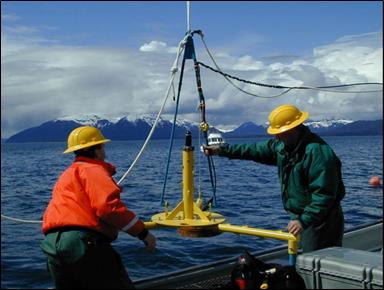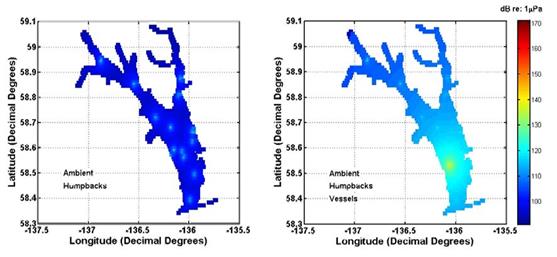How does underwater sound affect humpback whales and other marine mammals? What can park managers do to minimize disturbance?
Project Dates
Ongoing since 2000
Did You Know?
Male humpback whales have been recorded singing on their Glacier Bay feeding grounds, mostly in the fall as they are preparing to depart for their breeding grounds in Hawaii. Singing is usually associated with tropical winter breeding.
Introduction

Since 2000, park biologists have collaborated with acousticians at the U.S. Navy and others in an effort to understand more about Glacier Bay’s underwater sound environment. The data gathered during this study will help guide management actions intended to protect endangered humpback whales.
Humpback whales are acoustically-oriented, relying on sound for basic life functions such as feeding, detecting predators, and maintaining social bonds. Vessel noise results in the temporary loss of “acoustic habitat” for whales summering in Glacier Bay many times every day. Vessel noise can interfere with whale communication and feeding, increase the opportunity for collisions between vessels and whales, or cause short- or long-term hearing loss. Park staff are interested in learning what, if anything, can be done to minimize sound disturbance. The first step is to develop a better understanding of it.
The specific objectives of the research are to:
- Describe “natural underwater sounds” such as wind, rain, and animal vocalizations.
- Describe vessel-generated sounds (frequency, loudness, duration, and how far the sound travels).
- Determine how vessel numbers, speed, and other operating parameters affect underwater sound.
- Understand how marine mammals use the underwater sound environment.
The public can listen to real-time underwater sounds collected by the hydrophone at two “listening stations” at Glacier Bay Lodge and the Visitor Information Station.
Methods
Since May 2000, a hydrophone near the entrance to Bartlett Cove has transmitted underwater sounds to a computer at park headquarters. The computer takes a 30-second sound sample every hour. Navy acousticians analyze and summarize the data and provide reports to the park. Their summaries help park staff understand the effects of different numbers of vessels, types of vessels, and vessel speeds on the underwater “soundscape” of Glacier Bay. With help from the NPS Natural Sounds and Night Skies Program in Fort Collins, CO, the acousticians are comparing sound levels before and after 2007 when vessel quotas and operating restrictions changed in Glacier Bay.
For several years Glacier Bay has also collaborated with the Bioacoustics Research Program at Cornell University. In 2007 researchers placed two marine autonomous acoustic recorders (“pop-ups”) in upper Glacier Bay to record 45 days of continuous acoustic data. The Cornell researchers are also using computer modeling to simulate whale and vessel movement through time and space to estimate acoustic habitat loss for humpback whales under various conditions.
Findings

In summer, one or more vessels are audible about 60% of the time, compared to 12% in winter. Small and large motorized vessels are audible to whales at distances of at least several hundred yards, and often considerably farther.
Most vessels are much quieter at slower speeds. The underwater noise environment in Glacier Bay are substantially quieter when vessels were required to travel at 13 knots rather than at 20 knots. Cruise ships are audible for 40-74 minutes each time they enter or exit the mouth of Glacier Bay, as measured by the hydrophone.
Learn More
Check out the Park website at: https://www.nps.gov/glba/naturescience/acoustics.htm
Last updated: February 15, 2018
